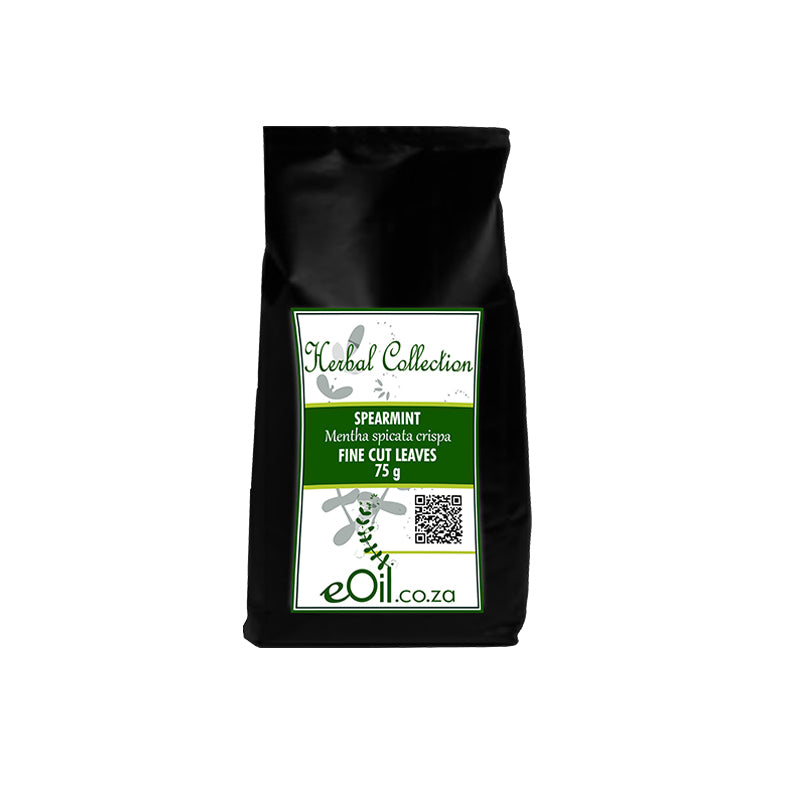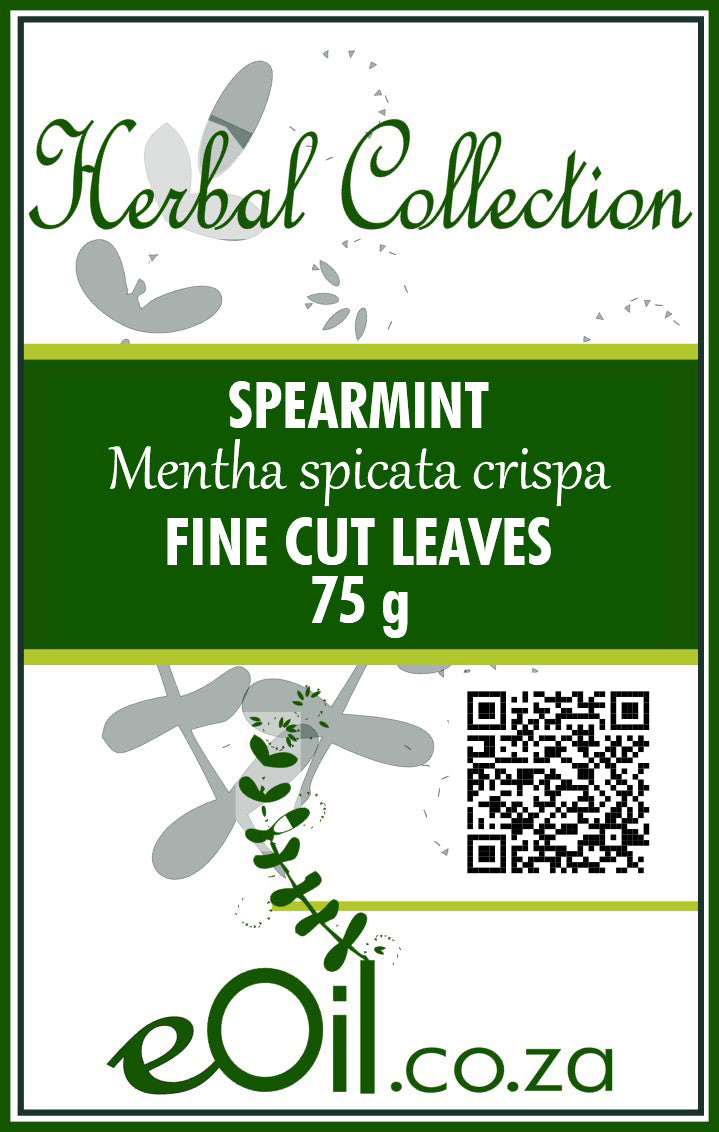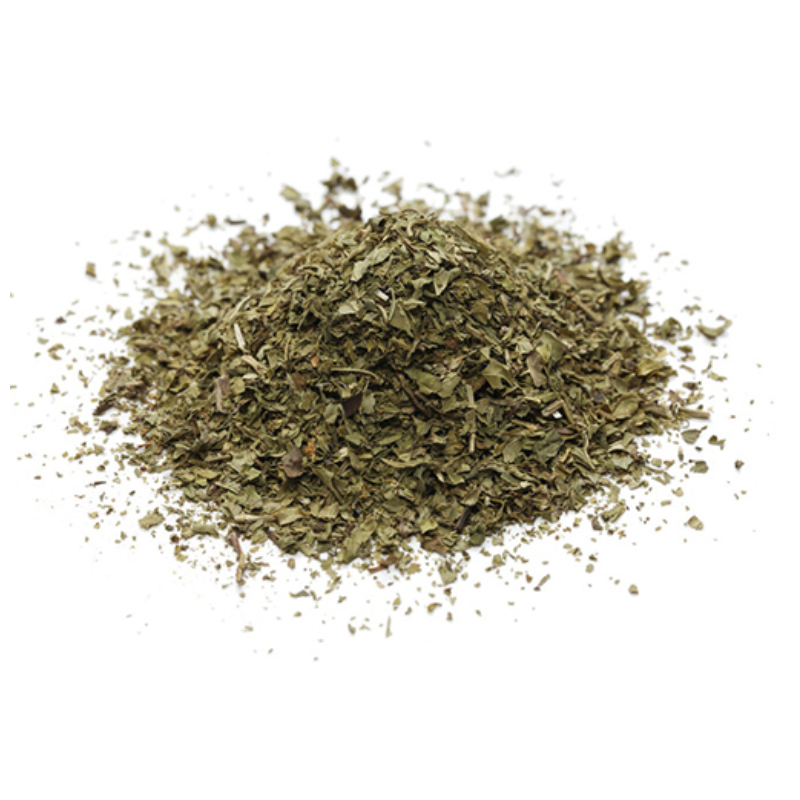Spearmint Crushed Leaves ( Fine Cut ) Dried - Herbal Collection
Spearmint Crushed Leaves ( Fine Cut ) Dried - Herbal Collection - 75 gr is backordered and will ship as soon as it is back in stock.
Description
Description
Spearmint Fine Cut Leaves Dried Crushed - 75 g and 1 kg - Herbal Collection
Mentha spicata
Spearmint, a refreshing herb with a sweet, minty aroma, has been enjoyed for centuries for its uplifting and invigorating qualities.
This versatile herb is often used to create flavorful teas and culinary dishes.
Spearmint may also offer support for digestion and can be a soothing addition to a relaxing evening routine.
For in depth information, please check tabs below
TRADITIONALLY USED FOR
What is Spearmint Tisane? Spearmint tisane is a type of herbal tea made from dried, fine-cut spearmint leaves. Spearmint (Mentha spicata) has a sweeter and milder flavor than peppermint.
Traditional Uses:
Spearmint tisane has been enjoyed for centuries and used for various purposes, including:
- Digestive Aid: Helps relieve indigestion, gas, bloating, and nausea.
- Stress Relief: Promotes relaxation and can help ease anxiety.
- Cold and Flu Remedy: Its menthol content can act as a decongestant and soothe sore throats.
- Hormonal Balance: May offer some support with regulating hormones in women.
- Antioxidant Boost: Provides antioxidants that fight cell damage.
How to Prepare Spearmint Tisane
- Measure: Use about 1-2 teaspoons of dried spearmint leaves per cup of hot water.
- Heat Water: Bring fresh water just to a boil (around 200°F or 93°C).
- Steep: Pour the hot water over the spearmint leaves and let them steep for 5-10 minutes.
- Strain: Strain out the leaves.
Sweeten (Optional): Add a bit of honey or your preferred sweetener if desired.
Enjoy! Spearmint tea can be enjoyed hot or cold.
INFORMATION
Source : http://www.wikiphyto.org/wiki/Spearmint
Reference on http://www.wikiphyto.org
Translation in English by Google Translate (go to the page of the source linked | on Chrome cellphones go on the 3 dots on the top right and select translate in your preferred language | on laptop right click your mouse and select option translate when hoovering on the page
plant name
Spearmint, spearmint, sweet mint , Moroccan nana , Moroccan mint
International Latin denomination
Mentha spicata L. or Mentha spicata Huds., Mentha viridis L.
botanical family
Lamiaceae
Description and habitat
- Common perennial herbaceous plant, rather Mediterranean, 60 cm high, deep green lanceolate leaves with serrated edges, young leaves light, flowers generally pinkish or even white in spikes
- It multiplies by stolons which can make it invasive in gardens
- Common subspecies:
- Mentha spicata var. twitched or var. crispata = curly mint ,, Roman mint , garden mint , crisp mint
- Mentha spicata var. longifolia = long-leaved mint , silver mint , wood mint ; synonym of spearmint Mentha longifolia
- Mentha spicata var. nana = nana mint (or nanah mint ), Moroccan mint , common in North Africa (Morocco), it would have been brought from Lebanon to Europe during the Crusades
- Common subspecies:
History and tradition
- It's the mint of restaurateurs and ice cream parlors
Parts used
Dosage forms available
- Menthes available in TM :
- Mentha arvensis tincture whole plant
- Mentha piperita tincture whole plant
- Mentha pulegium tincture whole plant
- Mentha rotundifolia tincture whole plant
- Mentha silvestris tincture whole plant
- Mentha viridis tincture whole plant
Usual dosages
Composition
Main components of the plant
Main components of buds or young shoots
Main components of essential oil
- Menthol , (-)- carvone (55-70%), (+)- limonene (10%), beta-myrcene , dihydrocarvone , 1,8-cineole (0.9-2.8%), 3-octanol , menthone , traces of pulegone
Properties
Plant properties
- Digestive
- Rosmarinic acid cultivars are strongly anti-inflammatory [1]
Bud properties
Properties of essential oil
- Inhalation of its essential oil is anti-emetic [2]
Indications
Indications of the whole plant (phytotherapy)
Indications of the bud (gemmotherapy)
Specific indications of essential oil (aromatherapy)
Known or suspected mode of action
Usual formulations
- Infusion: 10 grams of fresh leaves in a cup of boiling water, infuse for 10 minutes, drink a cup after meals
- Poultice of fresh leaves: to apply on insect bites or bruises
- Tonic and refreshing syrup:
- Ingredients: 2 bowls of mint leaves, one liter of boiling water, 1 kg of sugar
- Wash the mint leaves, drain them well, put them in a glass container or a heat-resistant pot, pour boiling water, leave to infuse covered for a day. Filter, add the sugar and cook again for another hour over very low heat. Skim and bottle when the syrup has cooled.
Regulations
- French Pharmacopoeia list A (leaf, flowering top)
Possible side effects and precautions for use
Bibliographic references
- Go↑ Wendy Pearson, Ronald S Fletcher, Laima S Kott, Mark B Hurtig. Protection against LPS-induced cartilage inflammation and degradation provided by a biological extract of Mentha spicata. BMC Complementary and Alternative Medicine. May 2010 [1]
- Go↑ Haniadka, R., Popouri, S., Palatty, P. L., Arora, R., & Baliga, M. S. (2012). Medicinal plants as antiemetics in the treatment of cancer: a review. Integrative cancer therapies, 11(1), 18–28. https://doi.org/10.1177/1534735411413266 PMID 21821652
CAUTION
Store in a cool, dry place, away from light. Keep tightly closed, away from the reach of Children and pets.
Do not exceed the daily dose.
This product is not intended to prevent or cure any form of illness or disease.
If you are pregnant or nursing ; If you have a medical condition or are in the course of medical treatment ; If you are programmed for theater/operation in the near future, please consult your healthcare practitioner before using this product.
This product cannot replace a varied and balanced diet and a healthy lifestyle.
This product has not been evaluated by the SAHPRA for its quality, safety or intended use.
For More Information please check our General Safety Herbal products Page

Spearmint Crushed Leaves ( Fine Cut ) Dried - Herbal Collection - 75 gr is backordered and will ship as soon as it is back in stock.






